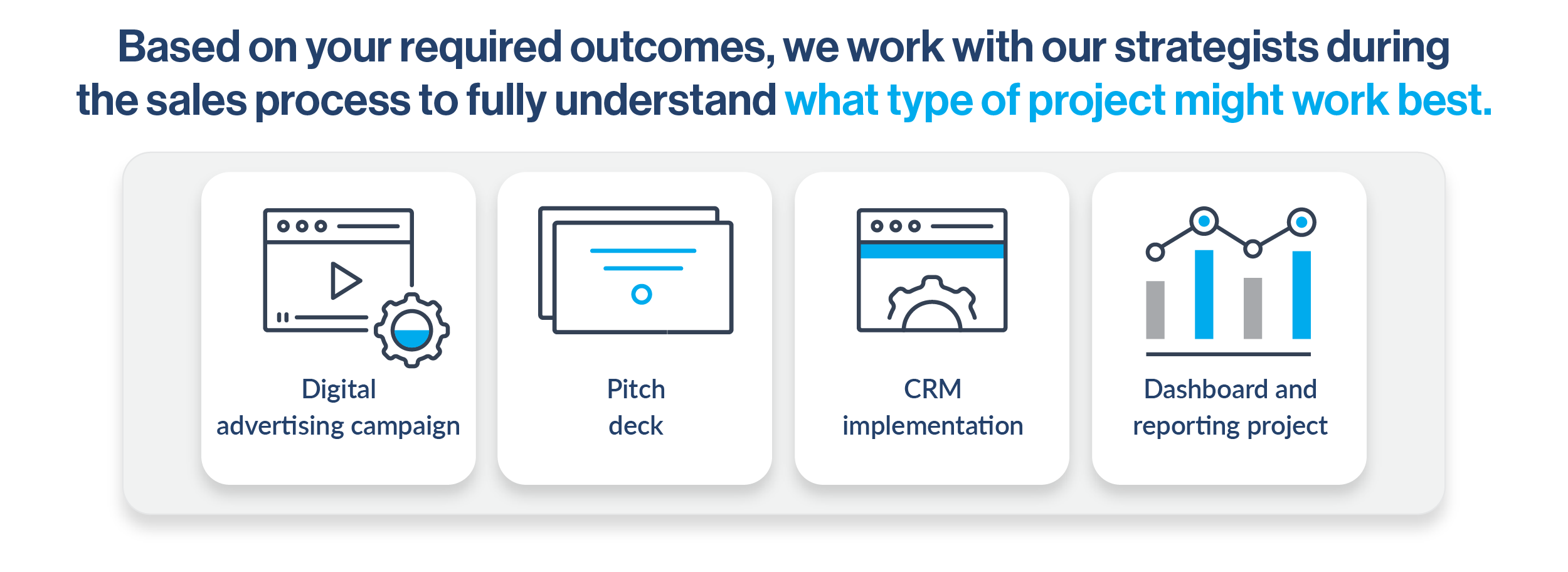Every marketing and sales leader has been there. You want to work proactively toward long-term goals, but you also need to get a job done right now. The leaders who can balance these seemingly-at-odds horizons tend to win.
At GK3, we’ve noticed that a rigid relationship with an agency doesn’t always allow for the smooth — or even successful — outcomes our financial services clients need to complete.
That’s what led us to Agile. Using this methodology, we’re able to help our clients prioritize the projects that add the most value. For example, if it makes the most sense for us to create a promotional ad campaign, we’ll design that project and a set of points that fulfill that goal.
Why do projects work, and how do we accomplish them together?
Let’s take a look.
GK3 Projects: Start-to-Finish Wins
The benefits of a project-based approach to your work are many:
1. Clarity and focus
Running a project allows you to define a scope and commit to deliverables. This sort of clarity can contribute to efficient, effective completion, and less distraction.
2. Flexibility
Using agile, projects aren’t rigid because they’re time-bound. Instead, the points value assigned to certain tasks within the project is what counts. As long as you can add or remove points as needed and keep your focus on the project goal, your project remains as flexible as a retainer, while letting you achieve the focus you need to get this job done.
3. Clear timeline
On time and on budget? Completely possible when you have a deadline and you’re committed to deliverables, as the agile methodology requires.
4. Budget awareness and control
You know what work needs to be completed and the budget you have to work with. A project can help you manage those costs effectively by drawing a clear line from spend to result. Speaking of, projects are also:
5. Results-oriented
The time-bound nature of a project means it has a standard for completion. All of the work that’s being done must, naturally, be results-oriented.
Of course, projects are just one aspect of your long-term strategy, but running a project with an agency can be more effective than you might think. Here’s how GK3 does it.
Scoping First
To ensure you get the most from your project, we start by examining your goals. What do you want to achieve? Based on your required outcomes, we work with our strategists during the sales process to fully understand what type of project might work best. Some examples:
You need to drive market awareness of a new offer. We determine that a digital advertising campaign would work well. We’d need a landing page, ads, and audience creation. We build the project scope from there.
You need a new pitch deck because you’re launching a new fund. We examine the information and materials you already have on hand and scope the length and type of document, and the required additional information, from there.
You need new leads but don’t have a CRM. We design a CRM implementation project.
You need your sales team to call everyone in your current CRM. We scope a dashboard and reporting project that will allow you to have eyes on all of your contacts and all of your sales team.

As you can see, in project scoping, anything is on the table. We follow your lead around goals and requirements and work together to devise the best solution.
Then, with timeline in hand, we kick off the project and start on sprint planning.
Distributing Agile Points and Client Meetings
Once the project scope is defined, GK3 assigns an account manager and key team members to our client’s account based on the desired project outcomes. Then, we all meet and dig into sprint planning. This is where we agree on how points are distributed. As mentioned, point distribution is based on the overall goals and objectives, too, and allows the team to prioritize the most valuable tasks and complete them in the right order.
From there, we’re up and running.
To ensure the project stays on track, our clients have weekly meetings with their account manager to discuss progress. These meetings provide an opportunity to identify any issues, make adjustments, and ensure that everyone is on the same page. Additional meetings are held every 30 days to confirm the next sprint, during which the team discusses the next set of deliverables.

Working with GK3 on a project is a collaborative effort that requires clear communication and goal alignment. By scoping out the project first, setting up Agile points, and having regular meetings with our clients, GK3 is able to ensure that each project is completed on time, on budget, and with the desired results. And they said it couldn’t be done!
Through this approach, GK3 has been able to help its clients achieve their long-term goals while also completing the job at hand — contributing to keeping that delicate balance.
Topics: Content Digital Marketing Digital Distribution Asset Management Website Sales Enablement CRM Automation Lead Generation Technology


.png)
